Musculoskeletal System
0.0 / 5
- Created by: Charlotte170289
- Created on: 04-12-20 14:45
Components of the Musculoskeletal System
The musculoskeletal system is made up of 2 different systems, the muscles and skeleton of the body.
It consists of the:
- muscles
- tendons
- ligaments
- bones and cartilage together with the joints.
The skeleton is the bone framework of the body. The connective tissues link the components are:
- ligament
- tenons
- cartilage
Articulations are the joints where movement occurs and muscles create movement,
1 of 38
Components of the Musculoskeletal System

2 of 38
Functions of the skeletal system
The skeletal system:
- is the central structure of the body and is made up of bones, joints and cartilage.
- provides the framework for muscles and gives the body the defined human shape.
- protects the internal organs and reduces the risk of injury on impact e.g. the cranium protects the brain, the ribs protects the heart and lungs, the vertebrae protects the spinal cord.
- allows movement of the body as a whole and its individual parts. The bones forms joints and acts as levers, allowing muscles to pull on them to produce movement. The bones provides surface for the muscle to attatch.
- blood cells are produced- certain bones containes bone marrow which produces red blood cells, white blood cells and platelets. Examples of bones that contain bone marrow are pelvis, sternum, humerus and femur. Approx 2.6 million red blood cells produced every second.
- stores minerals- the bones stores minerals such as calcium, iron, potassium and phosphoros and releases them into the blood when the body needs to use them necessary for vital body functions.
- Storage of lipids in the yellow marrow, these can turn into red marrroe in cases of severe red blood cells depletion.
3 of 38
Functions of the muscular system
The muscular system:
- Allows movement- the muscles pull on the tendons which in turn pulls on the bone. Movement is produced by the contractions of the muscles.
- Posture and body positions are maintained by constant muscle adjustments.
- Supports and protects the soft tissues and organs e.g. the abdominal walls protects stomach, liver and other internal organs.
- Maintains the body temperature.
4 of 38
The skeleton- Axial skeleton
Axial skeleton:
- Is formed bu the vertebral column (the spine), rib cage and the skull
- The upright posture of the human body is maintained by the axial skeleton, which transmits the weight from the head, the truck (torse) and the upper extremities down to the lower extremities at the hip joints

5 of 38
The skeleton- Appendicular skeleton
Appendicular skeleton:
- Is made up of the pelvic, pectoral (shoulder) gridles and the bones and cartilages of the upper and lower limbs (arms and legs)
- Their functions are to make movement possible and to protect the major organs of the digestive, excretion and reproduction systems
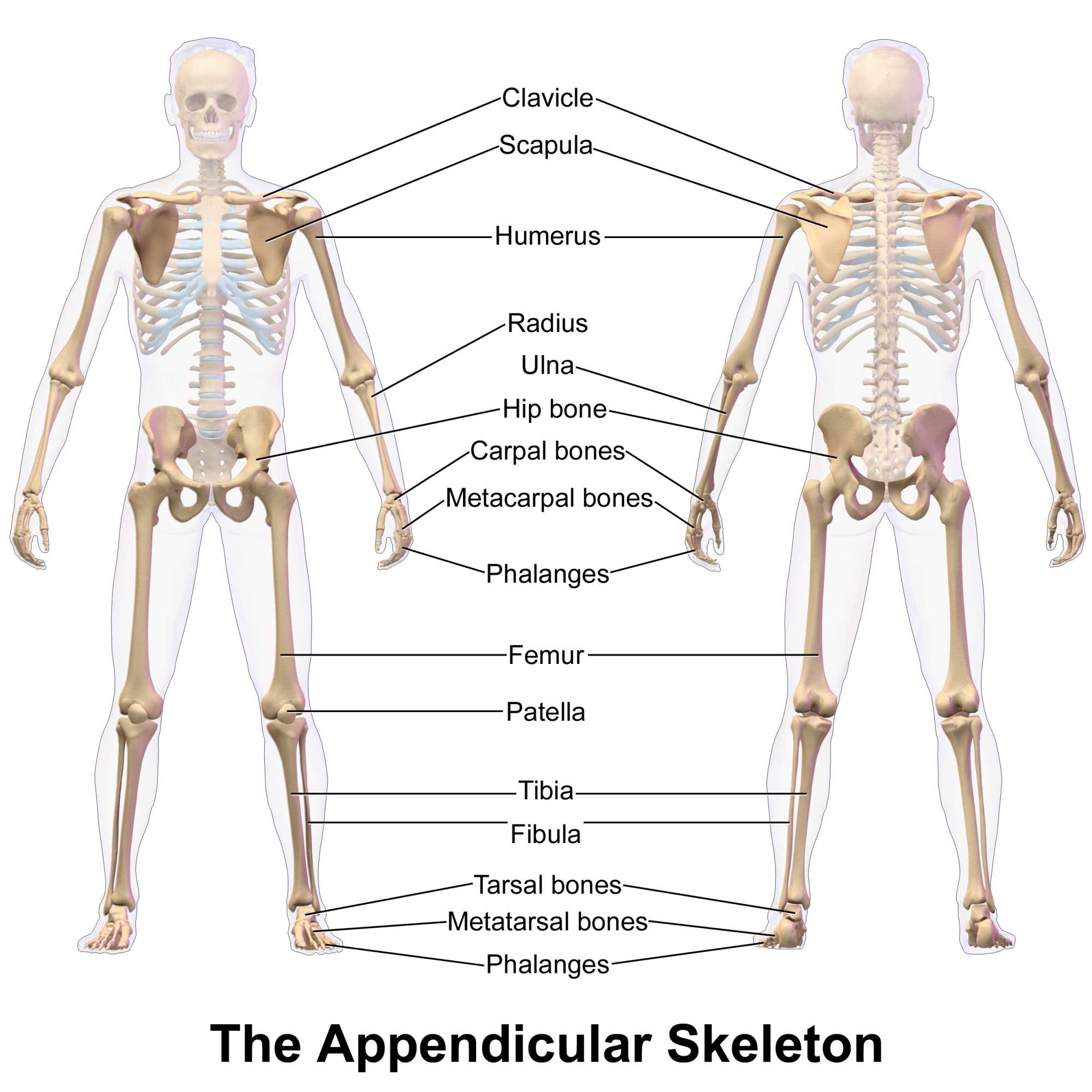
6 of 38
The skeleton
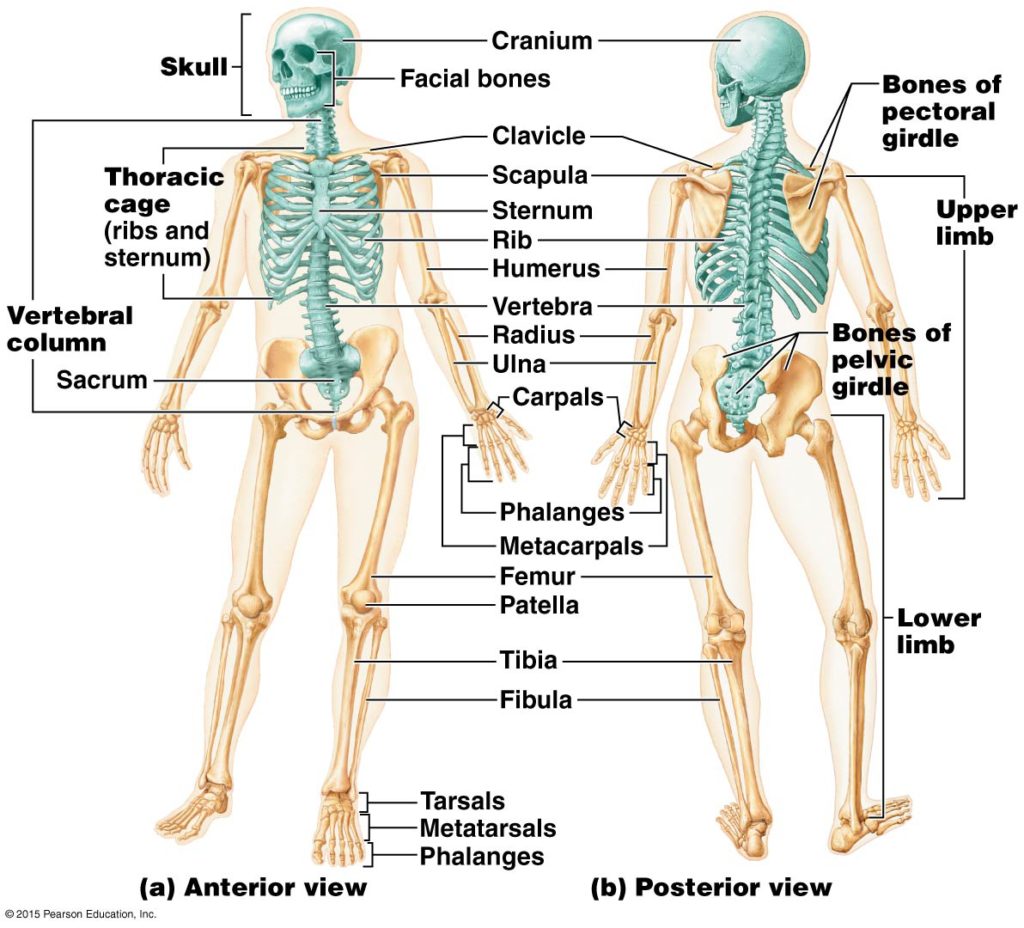
7 of 38
Classification of bones
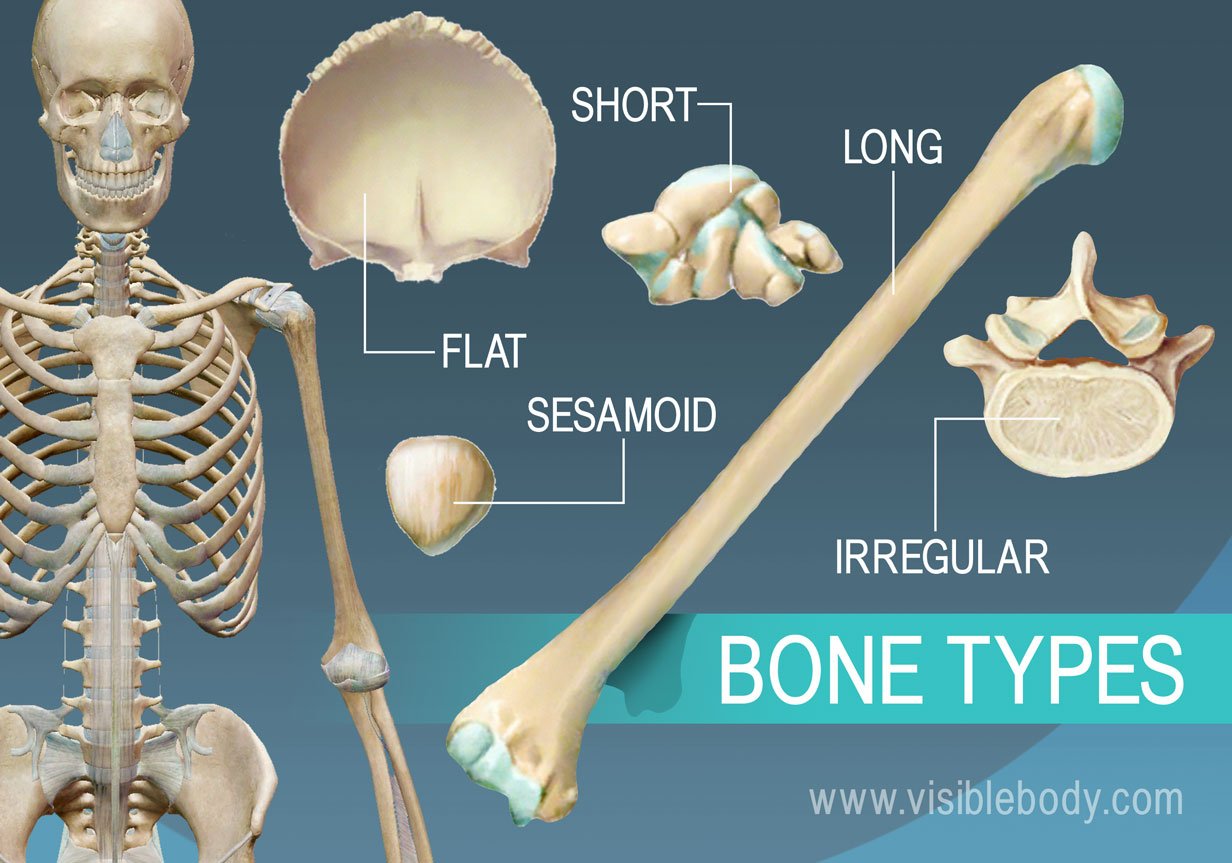
8 of 38
Classification of bones- Sesamoid bones
Sesamoid bones:
- Are usually short ot irregulat bones embedded in a tendon.
- The most obvious example of this is the Patella which sits within the Patella tendon.
- Other sesamoid bones are the Pisiform (smallest Carpal) and the two small bones at the base of the 1st metatarsal.
- Sesamoid bones are usually present in a tendon where it passes over a joint which serves to protect the tendon.


9 of 38
Classification of bones- Long bones
Long bones:
- Classification of a long bone includes having a bone which is longer then it it wide, with growth plates (epiphysis) at either end, having a hard outer surface of a compact bone and a spongy inner known as cancellous bone which contains bone marrow.
- Both ends of the bone are covered in hyaline cartilage to help protect the bone and aid shock absorption.
- They consist of Articicular cartilage which is the white, smooth tissue that covers the ends of the bone where they come together to form a joint which can be damaged by injury or normal wear and tear. Healthy cartilage in out joints make it easier to move.
- They are strong bones as they must be able to withstand the force generated when the body moves and changes direction.
- There are no lond bones found in the Axial skeleton.
- Every long bone is capped with wide areas on each end which are callled epiphyses.
- The longest part of the long bone is the long cylindrical middle called the diaphysis which takes the brunt of the force a long bone must support and is made up of compact bone.
- Dont be fooled! long bones are some of the longest bones in the body, such as the femur, humerus and tibia but are also some of the smallest bones including the Metacarpals, Metatarsals and Phalanges.
10 of 38
Classification of bones- short bones
Short bones:
- Are defined as being approximately as wide as they are long and have a primary function of providing support and stability with little movement.
- Examples of short bones are the Carpals and Tarsals
- They consist of only a thin layer of compact, hard bone with cancellous bone on the inside along with relatively large amounts of bone marrow.
- Short bones are shaped similar to a cube.
- Short bones are found mainly in the ankles and wrists.
- Short bones are less compact bones and more spongy bones making them more likely susceptible to compression and even breaking.
11 of 38
Classification of bones- Flat bones
Flat bones:
- Are strong flat plates of bone with the main function of providing protection to the bodies vital organs and being a base for muscular attachment.
- They have a large, flat surface
- Anterior and posterior surfaces are formed of compact bone to provide strength for protection with the centre consisting of cancellous (spongy) bone and varying amount of bone marrow.
- In adults, the highest number of red blood cells are formed in flat bones.
- The classic example of a flat bone is the scapula (shoulder blade). The Sternum, Cranium, Ilium, Pelvis and Ribs are also classified as flat bones.
12 of 38
Classification of bones- Irregular bones
Irregular bones:
- Are bones in the body that do not fall into any other category due to their non-uniform shape.
- Some examples of irregular bones are: the vertebrae, sacrum and mandible.
- They primarily consist of cancellous bone with a thin outer layer of compact bone.

13 of 38
Classification of bones

14 of 38
Bone structure
Bones are:
- Covered by a layer of protective periosteum
- The outer layer is compact bone
- The inner layer is a spongy bone
- Hollow marrow cavity- Yellow marrow adipose (fat) tissue- Red marrow (oly in epiphyses and flat bones in adults)
15 of 38
Periosteum
- Consists of dense irregular connective tissue
- It is divided into an outer "fibrous layer" and an inner "cambium layer"
- The outer layer "fibrous layer" is composed of collagen producing cells called fibroblast and contains nerve fibres that causes pain when damaged due to the nociceptive nerve endings. It also has a rich supply of blood vessles and branches which enter the bone to supply osteocytes or bone cells.
- The inner "cambium layer" is comprised of progenitor cells that gives rise to osteoblast which are the bone making cells. Strong collagenous fibers from the cambium penetrate the underlying bone along with blood vessels to form sharpey fibers in order to undergo binding.
- It also provides nourishment by providing the blood supply to the body from the marrow
- The periosteum that covers the outer surface of the bones of the skull is known as the "pericranium"
- Is the tough connective tissue membrane that covers the outside of the bone (except where there is articular cartilage)
16 of 38
Compact bone
- Compact bone is also called cortical bone, Is strong, dense bone tissue
- Compact bone is used to create most of the hard structure of the skeleton, for support, protection and movement.
- Forms the cortex, or hard outer shell of most bones in the body.
- Compact bone is formed from a number of osteons which are circular units of bone material and blood vessels allowing the bone to remain hard and compact while still receiving nutrients from the body, disposing waste in the same way.
- Each osten is also made up of a number of cells responsible for the maintenance of the bones including osteocytes and osteoblasts.
- Compact bone is also serve a function in storing and releasing calcium to the body when needed.
- Compact bone provides a strong mechanical levers against which the muscles can create movement.
- Is dense bone in which the bony matric is solidly filled
- Has only tiny spaces (lacunae) that contains the osteocytes, or bone cells
- Compact bone makes up 80% of the human skeleton, Compact bone forms a shell around the spongy bone
- It is the primary component of the long bones of the arms and legs where its greater strength and rigidity are needed.
- Osteons- functional units of compact bone, created by a network of bone cells and blood vessels
- Osteocytes- a cell which function to maintain and repair bone tissue
- Osteroblast- cells which lay down new bone tissue, adding the matrix
17 of 38
Compact bone structure
18 of 38
Spongy bone
- Spongy bone is also known as the Cancellous bone
- It is light, porous bone enclosing numerous large spaces that gives a honeycombed or spongy appearance
- Makes up about 20% of the human skeleton
- Provides structural support and flexibility without the weight of compact bone
- It can develop into compact bone through the action of bone-forming cells called Osteoblasts.
- The spaces within the spongy bone contains the red and yellow bone marrow and blood vessels and stem cells which can be used to repair damaged or broken bones.
- Spongy bone/Cancellous bone is oftern found at the end of long bones, as well as in the pelvic bones, ribs, skull and the vertebrae in the spinal column.
19 of 38
The Haversian system
- Also known as an Osteon
- It is a series of concentric circles called lamellae found in the compact bone.
- Down the middle of each of these systems is a hollow tube that holds a blood vessel.
- Within the Lamellae of each Haversian system are a series of spaces called Lacunae. The Lacunae holds the Osteocytes or bone cells.
- The blood vessels that run down the middle of the Haversian system provides nutrients to the living bone tissue
- Nerves and Lymph vessels are also found in the Haversian canals.

20 of 38
Therefore bones...
- Have a good blood supply
- Have sensation
- Are strong but with a degree of flexibility
- Are living structure with the abaility to repair when damaged
- Have an important role on storing minerals
- Are essential for production of red blood cells (oxygenation of tissues) and white blood cells (protection and immunity)
21 of 38
Vertebral column
- It is formed from individual bones called vertebrae which houses the spinal canal that encloses and protects the spinal cord.
- Vertebrae are defined by the regions of the vertebral column that they occur in
- It usually consists of 33 vertebrae: the upper 24 are articulating vertebrae, separated by intervertebral disks and the lower nine are fused, five fused in the sacrum and four in the coccyx.

22 of 38
Joints
There are three structural classifications of joints:
- Fibrous joint- joined by dense regular connective tissue that is rich in collagen fibres e.g. Skull
- Cartilaginous joint- are formed by a pad of fibrocartilage, a tough material that acts as a shock absorber e.g. pubic symphysis
- Synovial joint- not directly joined- the bones have a synovial cavity and are united by the dense irregular connective tissue that forms the articular capsule. Highly moveable found at the end of the long bone e.g. knee. They have a space/cavity between the articulating bones. The end of the bones are held together by a sleeve of fibrous tissue and the capsule are lubricated with a small amount of fluid.
23 of 38
Cartilaginous joints
- Cartilaginous joints are connected entirely by cartilage (fibrocartilage or hyaline)
- Cartilaginous joints allow move movement between bones than a fibrous joint but less than the highly mobile synovial joint. Cartilaginous joints also form the growth regions of immature long bones and the intervertebral discs of the spinal column.
- There are both primary and secondary cartilaginous joints.
24 of 38
Primary cartilaginous joints
- Primary cartilaginous joints are known as synchondrosis
- These bones are connected by hyaline cartilage and sometimes occur between ossification centres.
- Some examples of promary cartilaginious joints in humans are the "growth plates" between ossification centres in long bones.
25 of 38
Secondary cartilaginous joints
- Secondary cartilaginous joints are known as "symphysis". These include fibrocartilaginous and hyaline joints, which usually occur at the midline.
- Some examples of secondary cartilaginous joints in human anatomy would by the manubriosternal joint (bewteen the manubrium and the sternum), intervertebral discs and the pubic symphysis.
- Articulating bones at a symphysis are covered with hyaline cartilage and have a thick, fairly compressible pad of fibrocartilage between them. Cartilaginous joints allow little movement.
26 of 38
Primary and Secondary cartilaginous joints
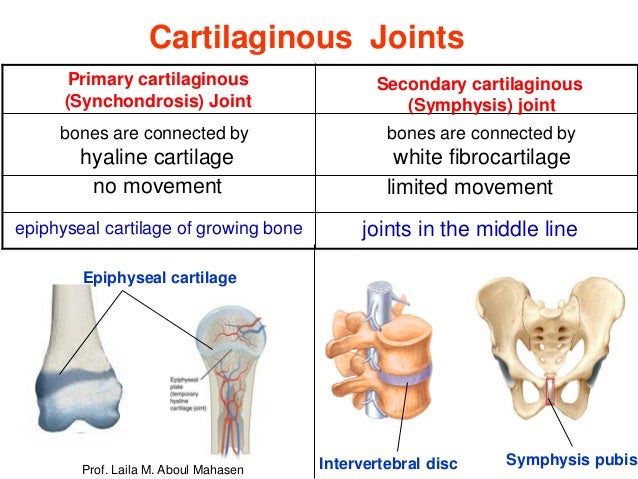
27 of 38
Structure of a Synovial joint
Articular cartilage
- Covers the bone ends
- Its smooth surface reduces friction
- Strong enough to absorb compression forces and bear weight of the body
- Thin layer of hyaline cartilage that covers the epiphysis of one bone where it forms a joint with another bone.
Synovial fluid
- Thick, sticky fluid secreted by epithelial cells
- Provides nutrients for structures
- Contains phagocytes which removes microbes and cellular debris.
- Acts as a lubricant
- Maintains joint stability
- A viscous, clear or pale yellow fluid containing hyaluronic acid and interstitial fluid that forms a thin film over articular capsule surface.
- Prevents the ends of the bones from being seperated
28 of 38
Structure of a Synovial joint cont..
Syonival membrane
- This epithelial layer lines the capsule and covers all non-weight-bearing surfaces inside the joint. It secretes synovial fluid
- The epithelial cells lining covering the capsule and bone that are not covered by articular cartilage
Articular capsule
- The parts of the bone which are in contact are always covered with hyaline cartilage.
- This provides a smooth articular surface, reduces friction and is strong enough to absorb compression forces and bear weight of the body.
- The joint is surrounded by a sleeve of fibrous tissue (capsule)
- Allows movement of the joint
- Protects from injury
29 of 38
Synovial joint
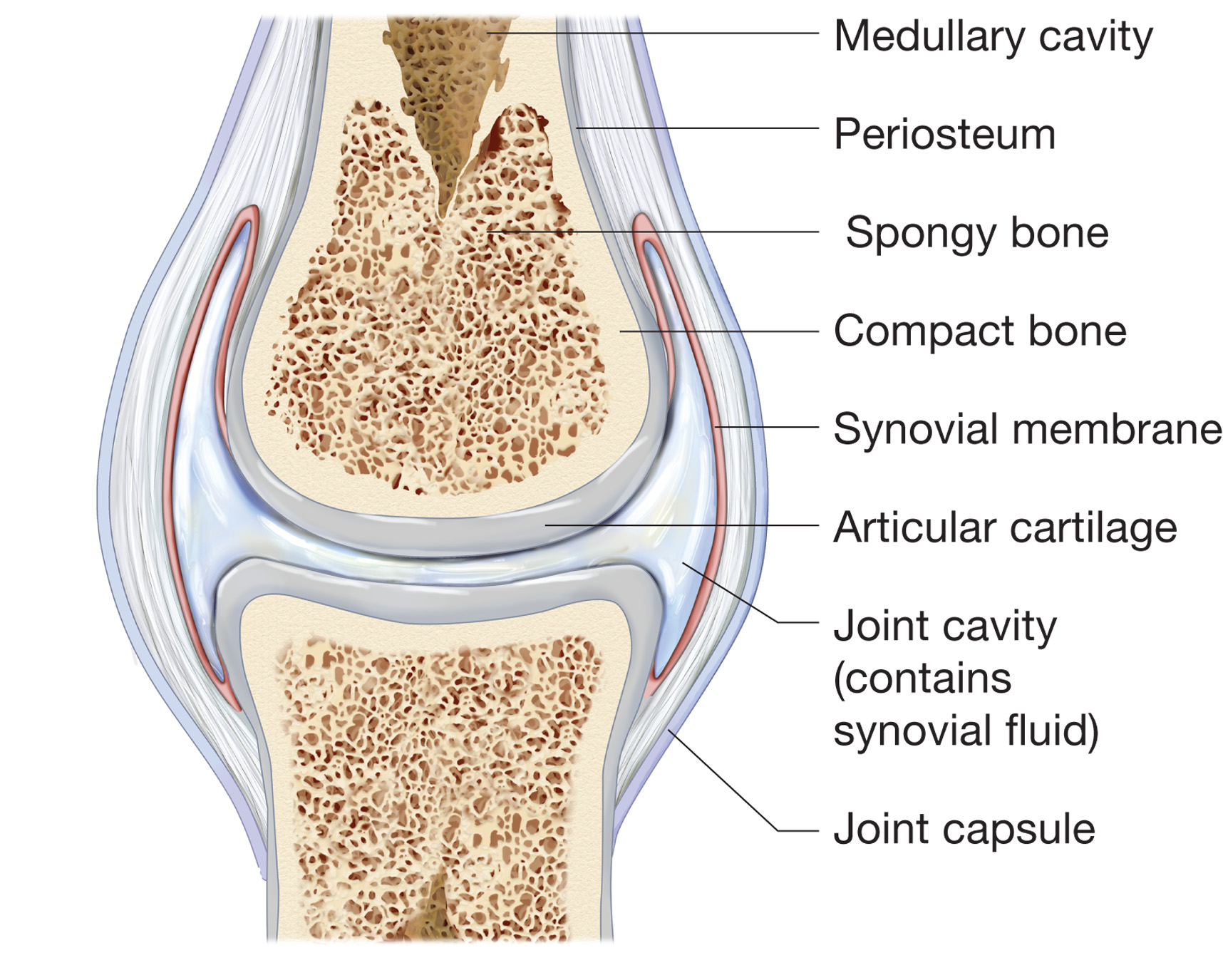
30 of 38
Skeletal muscle (voluntary)
- This type of muscle is also called valuntary muscle because there is conscious control over it via the nervous system.
- These muscles are attatched to bone via tendons and are used to move the skeleton
- Superficial muscle that lies over the skeleton and gives the body its shape and definition
- It can also be referred to as striped or striated muscle due to the characteristic banded pattern of the cells seen under the microscope.
The Skeletal muscle is made up off
- Muscles cells (fibres)
- Connective tissues
- Blood vessels
- Nerves
31 of 38
Skeletal muscle
- Connective tissues cover the muscle fibres (endomysium), bundles of cells (perimysium) and the muscle body.
- Connective tissues come together at the muscle ends to form tendons

32 of 38
Muscle contraction (shortening)
- The skeletal muscle cells contracts in response to stimulation from a nerve fibre which supplies the muscle cell usually around have way along its length.
- Nerve impulses from the brain stimulate muscle cells in the muscle body e.g. biceps brachii
- When the action spreads down the nerve along the sarcolemma, it conducts deep within the muscle cell through a special network of channels that run through the sarcoplasm, releasing calcium from the intracellular stores
- Calcium triggers the binding of myosin to the actin filament next to it, forming a cross bridge
- Protein filaments (ATP) then provides the energy for the 2 filaments to slide over each other, pulling the z lines at each end of the sarcomere closer to one another, shortening the sarcomere
- If enough fibres are stimulated the whole muscle with contract (shorten).
- The Muscles pulls on tendons creating leverage on the bones enabling movement

33 of 38
Movement
- Mucles work in pairs or groups called antagonistic pairs- many muscles/ muscle groups of the body are arranged so that thir actions oppose one another.
- In order to move a body part the muscles or its tendons must stretch across at least one joint
- When it contracts the muscle pulls one bone to another, the action caused by contraction of the biceps brachii is flexion
- The action caused by contraction of the Triceps brachii is extension

34 of 38
Smooth muscle
- Smooth (involuntary or non-striated) muscle is not under conscious control.
- The cells are small, have one nucleus and are spindle shaped.
- Unlike skeletal and cardica muscle, smooth muscle cells do not have a striped appearance under the microscope
- Smooth muscle forms sheets in the walls of hollow organs and tubular structures to regulate diameter and propel substances through tracts
- Some smooth muscle has the ability to initiate their own contraction independently of nerve stimulation (automaticity)
- Muscle cells are found in the walls of hollow organs including the stomach, intestines, urinary bladder and uterus, and in the walls of passageways such as the arteries and veins of the circulatory system and the tracts of the respiratory, urinary and reproductive system
- In the skin, smooth muscle cells cause hair to stand erect in response to cold temperature or fear
- The smooth muscle in the uterus helps a woman push out her baby. In the bladder, smooth muscles helps to push out urine. Smooth muscle determines the flow of blood in the arteries. Smooth muscles move food through the digestive tract
35 of 38
Smooth muscle

36 of 38
Cardiac muscle
- Cardiac muscle is an involuntary, striated muscle that constitutes the main tissue of the walls of the heart
- The myocardium forms a think middle layer between the outer layer of the heart wall (the epicardium) and the inner layer (the endocardium)
- It is composed of individual heart muscle cells (cardiomyocytes) joined together by intercalated discs, encased by collagen fibres and other substances forming the extracellular matrix
- Cardiac muscle contracts in a similar manner to skeletal muscle
- cardiac muscle cells or cardiomyocytes are the contracting cells which allow the heart to pump
37 of 38
Cardiac muscle
38 of 38
Similar Nursing resources:
0.0 / 5
0.0 / 5
0.0 / 5
0.0 / 5
0.0 / 5
0.0 / 5
0.0 / 5
0.0 / 5


Comments
No comments have yet been made